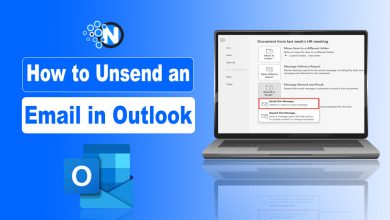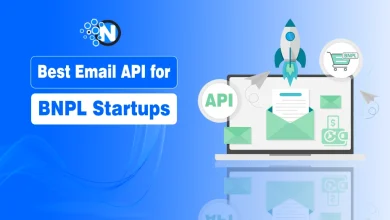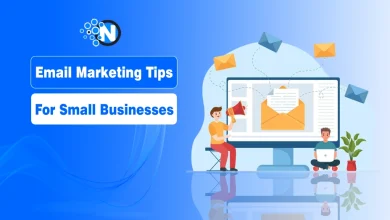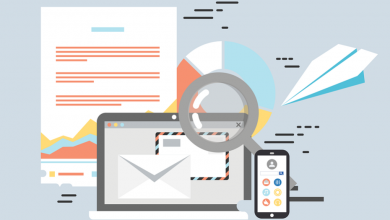Top Email Marketing Campaign Goals to Drive Your Business

Email is central to all stages of customer relations: prospecting, engagement, and loyalty. Because it is easily accessible, it is the most widely used marketing medium. With so much competition, making your emails stand out can be challenging. A good email design can help you break the ice with potential readers and immediately capture their attention. But what is the primary goal of email marketing?
The primary goal of email marketing is to engage, inform, and convert recipients by delivering personalized and valuable content straight to their inbox. Businesses use email marketing to build relationships with customers, boost brand awareness, and drive sales.
Keeping this all in mind, I have mentioned a brief discussion of some of the best email marketing campaign goals in this blog post.
Let’s start!
Why Setting Goals for Email Marketing Campaigns Matters?
A clearly defined set of goals establishes the direction for email marketing campaigns. Without them, it is like driving a car with no particular route to follow; one may move but is in a state of confusion as to where he is headed.
Goals provide your campaigns with direction and definition to evaluate and enhance them. It also makes it easier to correlate the content of the e-mail with the overall strategic goals of the business. Everything from lead nurturing to overall sales growth can be attributed to goal-driven emails, which are the key to effective marketing strategies.
<strong>Subject</strong>: ………………………………
Definition of Email Marketing Campaign
An email marketing campaign is a coordinated set of individual email messages delivered over a specific period of time for a specific purpose. These campaigns are intended to reach a targeted audience to achieve a particular goal, such as promoting a product, sharing news, or encouraging engagement.
Key Goals for Successful Email Marketing Campaigns
Setting specific goals narrows your focus and fine-tunes your approach. Here are the primary successful email marketing goals that should aim to achieve:
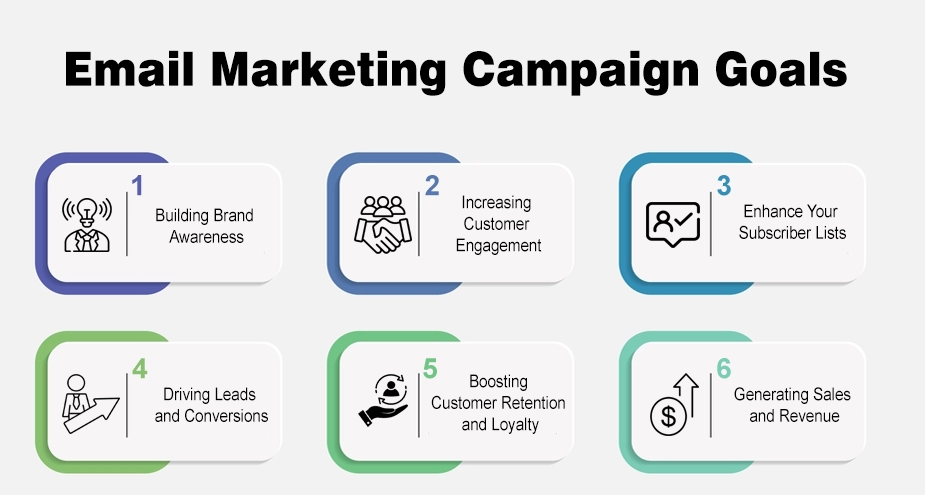
- Building Brand Awareness
- Increasing Customer Engagement
- Enhance Your Subscriber Lists
- Driving Leads and Conversions
- Boosting Customer Retention and Loyalty
- Generating Sales and Revenue
1. Building Brand Awareness
Brand awareness simply means getting your name, products or services to the attention of more people. In the case of e-mail marketing, you can inform new customers of your brand, as well as remind those who are already subscribed to your newsletter.
Reliable brand emails present consistent personality, tone and values of the brand under correspondence. The content you send out is useful and relevant to the brand; users can easily identify the name in the end and build trust in the long run.
2. Increasing Customer Engagement
The likelihood of an engaged subscriber taking some sort of action—such as purchasing something, sharing something, or clicking a link—is higher. Building engagement is essential for accomplishing other objectives in email marketing.
The likelihood of your emails being read and clicked is enhanced by creating attention-grabbing subject lines, employing personalized greetings, and segmenting your list. Evaluating other aspects of an email, such as images and calls to action, can help increase engagement rates.
3. Enhance Your Subscriber Lists
The number of subscribers you’re able to find is often responsible for the reach and success of your campaigns. Broadening the scope is important to reach net new customers; also having a constantly rotating community ensures that it stays relevant.
Free stuff, like eBooks, free trials, or a specific percentage off, work wonders in increasing the list of subscribers. This is helpful when people know that they stand to benefit from something you are promising in the emails.
4. Driving Leads and Conversions
Another great advantage of email marketing is that it creates a cycle for delivering highly relevant and useful information that leads to sales. Personalization overshadows it; it is not just a matter of using the customer’s first name.
Categorize your list of subscribers to differentiate between them based on aspects such as age, previous purchases or their browsing history so as to create content that is engaging and more effective in encouraging the desired action. This contributes to an increased number of conversions and, in general, the success of the campaigns.
5. Boosting Customer Retention and Loyalty
Customers are a great treasure to your business, and email marketing is an effective way of cultivating customer retention and loyalty. Loyalty members should be rewarded with extra content and priority in new product releases, or you may give them a separate discount rate. This not only extends gratefulness but also deepens the relationship shared with the brand.
6. Generating Sales and Revenue
At the end of the day, one of the main goals of any marketing campaign is to increase revenue, and email marketing is a major contributor. You need to make your CTAs simple and attractive to get a quick response from the users.
Monitor the revenue-related variables such as return on investment, customer conversion rate, and average monetary value of an order. These analyses enable you to assess the efficiency of your campaigns in terms of sales and revenue.
Creating a Great Email Marketing Campaign
A well-crafted email marketing campaign can boost engagement, drive sales, and strengthen customer relationships. Here’s how to create an effective campaign:
Objectives and Purpose
Your objectives determine the purpose of your campaign and the results you want to achieve. As a result, they must be as detailed as possible. Define your campaign’s overall goal: Is it increasing your open rate for the upcoming holiday? Or maybe a Black Friday Marketing Deal?
After you’ve defined the overall goal, divide it into specific objectives that can be measured precisely. If you have specific objectives, it will be easier to structure your campaign and evaluate its success. For example, if you want to increase your click-through rate, specify the percentage you want to achieve. However, no two campaigns are alike: set relevant and important email marketing objectives for your business.
Make Compelling Email Marketing Design
Do you struggle to create effective campaigns and reach the objectives of email marketing? During the holidays, things can become even more complicated. So, I’ve compiled some guidelines to help you prepare smoothly for this busy time of year:
- Storytelling: With a successful storytelling strategy, you can increase long-term customer loyalty and boost the awareness of your brand’s mission. Remember that you need to think carefully about the message that will enter your subject line
- Customization: Sending emails that do more than just promote offers or products shows your customers how important they are to you. Personalize each message, both in the subject line and in the body. For example, a customized list of gift ideas or a gift-wrapping tutorial for your products
- Persuasion: Make sure that links to your social media profiles are easily visible, or use call-to-action buttons to increase social media sharing.
- Short and direct messages: Send messages that are relevant and easy to understand. Exclude unnecessary information and be specific about what you want to convey. Your text and images should be perfectly balanced.
- Maintain a professional tone and style: Many businesses attempt to sell their products and services during the holiday season. Be succinct. Use a friendly tone and show your holiday spirit – enthusiasm is contagious.
- Make an emotional connection with your readers: Your message will be more effective if you make emotional and personal connections. There are numerous possibilities for joy, enthusiasm, and love. Select the images based on your goal and the call to action approach.
- Thematic design: Adapt your email design to the season using fresh colors and simple patterns. Go for flashy and attractive options but without saturating the customer.
Monitor and Keep Analyzing
Determine and closely monitor key performance indicators that are relevant to your campaign. Keep an eye on these statistics to see how effectively your message reaches your subscribers and how readers respond.
For example, suppose you have a particular holiday page or a specific coupon code on your site. In that case, you can analyze the number of visitors who viewed the page, the associated conversion rate, and the frequency with which the coupon code was used. Finally, carefully measure your offers’ results to evaluate their performance at the campaign’s end.
Fine-Tune Your Email Marketing Efforts
A/B testing, or split testing, is a method that helps marketers optimize their email campaigns by comparing two variations of an email to see which performs better. It is vital for identifying the audience preferences, or in other words, for enhancing the efficiency of the campaign in general.
A/B testing of email marketing involves sending two versions of an email to different audience segments. In such testing, you can test one variable, for instance, the subject line, call to action button, or image, and compare which variant would be most effective regarding click-through rates or conversion rates.
Final Words
You have access to all the methods for developing an effective email marketing strategy. A few more points are worth emphasizing. You must have a long-term vision that ensures proper consistency in the goals of email marketing. Determine major corporate and general events where appropriate commercial offers can be launched. These are the benchmarks for planning a season-specific campaign.
Social networks are also crucial to promote social media sharing; incorporate share buttons in your sales email. Sharing buttons have a higher click-through rate than forward buttons. Email remains the most prevalent method of prospect and customer communication. Many holiday campaigns oversolicite recipients. For your organization to succeed, pay attention to every aspect.

